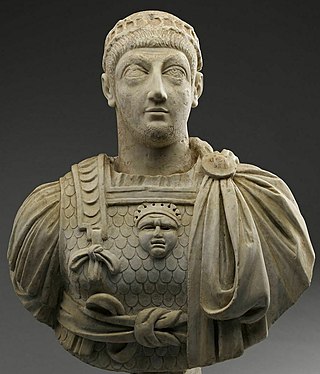Related Research Articles
The 430s decade ran from January 1, 430, to December 31, 439.
The 510s decade ran from January 1, 510, to December 31, 519.
The 450s decade ran from January 1, 450, to December 31, 459.

Year 515 (DXV) was a common year starting on Thursday of the Julian calendar. At the time, it was known as the Year of the Consulship of Florentius and Anthemius. The denomination 515 for this year has been used since the early medieval period, when the Anno Domini calendar era became the prevalent method in Europe for naming years.

Valentinian III was Roman emperor in the West from 425 to 455. Made emperor in childhood, his reign over the Roman Empire was one of the longest, but was dominated by powerful generals vying for power amid civil wars and the invasions of Late Antiquity's Migration Period, including the campaigns of Attila the Hun.

Pal Ëngjëlli was an Albanian Roman Catholic cardinal, clergyman, scholar, and Archbishop of Durrës who in 1462 wrote the first known sentence retrieved so far in Albanian. Pal Ëngjëlli is reported to have been a friend, co-worker and close counselor of Skanderbeg. As his envoy, he frequently traveled abroad, seeking for aid in the war against the Ottoman Empire. Pal is the Northern Albanian version of Paul, and Ëngjëlli is the Albanian form of angel.

Aelia Ariadne was Eastern Roman empress as the wife of Zeno and Anastasius I. She is venerated as a saint in the Eastern Orthodox Church, with her feast day falling on August 22.

Bilbor is a commune in Harghita County, Transylvania, Romania. It is composed of two villages, Bilbor (Bélbor) and Răchitiș (Rakottyás).

The Anastasian War was fought from 502 to 506 between the Byzantine Empire and the Sasanian Empire. It was the first major conflict between the two powers since 440, and would be the prelude to a long series of destructive conflicts between the two empires over the next century.
Vitalian was a general of the Eastern Roman Empire. A native of Moesia in the northern Balkans, and probably of mixed Roman and Gothic or Scythian barbarian descent, he followed his father into the imperial army, and by 513 had become a senior commander in Thrace.
Flavius Patricius was a prominent East Roman (Byzantine) general and statesman during the reign of Byzantine emperor Anastasius I.
The Isaurian War was a conflict that lasted from 492 to 497 and that was fought between the army of the Eastern Roman Empire and the rebels of Isauria. At the end of the war, Eastern Emperor Anastasius I regained control of the Isauria region and the leaders of the revolt were killed.
The formula e pagëzimit is the oldest written document with a writing in Albanian which has been found. The document is “Codex Ashburnham” dated November 8, 1462, and it contains various notes on Albania written in Latin by Archbishop Pal Engjëlli.
Pompeius was a politician of the Eastern Roman Empire and nephew of the Emperor Anastasius I. His family gained political prominence with the accession of Anastasius. Pompeius was consul in 501, and was elevated to the patricianate, probably by Anastasius. He held military office, serving in the Iberian War. He married a woman named Anastasia, and had at least one son. In 532, Pompeius' brother Hypatius was acclaimed emperor by the rioters during the Nika riots; after the riots were put down, both Hypatius and Pompeius were executed.
Ascum was a general of the Byzantine Empire, active early in the reign of Justinian I. He was in command of the Praetorian prefecture of Illyricum. His name is reported by John Malalas. Both Theophanes the Confessor and George Kedrenos render his name "Ακούμ" (Acum).
Marinus was one of the most trusted and senior aides of the Eastern Roman emperor Anastasius I. He served twice as praetorian prefect of the East, supervised some of Anastasius's tax reforms, supported the Emperor's pro-Monophysite policies and led the Roman navy in a crucial battle that ended for good the rebellion of general Vitalian in Thrace. He survived into the regime of Justin I, when he held his second tenure as praetorian prefect, but was soon sidelined from power.
Mihai Băcescu was a Romanian zoologist.
The Banat Socialist Party was a political party in the Banat, Romania. The party was founded by social democratic branches in Banat on September 19, 1919, as the Banat Social Democratic Party. In December 1919, the party merged with the Social Democratic Party of Transylvania, but retained its autonomy. The name Banat Socialist Party was adopted at a party conference on May 2, 1920. The party was affiliated to the Federation of Socialist Parties in Romania.
Tarrach was a Hun military officer for the East Roman Empire. He was the assassin of the officer Cyril. Tarrach was credited as the "fiercest of the Huns".
Rufinus was a Byzantine military officer and emissary of the 6th century, active during the reigns of emperors Anastasius I Dicorus, Justin I, and Justinian I. Of Greek origin, he was the son and brother, respectively, of the officers Silvanus and Timostratus. He first appeared in 502, when he was sent by Anastasius to the court of the Sasanian shah Kavad I with large amounts of money to prevent attacks on the Byzantine Empire. When Rufinus learned of the Persian attacks, he left the money in Caesarea and met in Amida Kavad I, who imprisoned him until January 503, when he was released and sent to the emperor.
References
- 1 2 Amory, Patrick (2003). People and Identity in Ostrogothic Italy, 489-554. Cambridge University Press. p. 357. ISBN 9780521526357 . Retrieved 12 November 2022.
- ↑ Academia Republicii Populare Romîne; Academia Republicii Populare Romîne.; Institut d'études sud-est européennes; Academia Republicii Socialiste România, Institutul de Studii Sud-Est Europene (Founded 1963) (2008). Revue des études sud-est européennes Volume 39, Issues 1-4. p. 12. Retrieved 12 November 2022.
- ↑ Bury, John Bagnell (1889). A History of the Later Roman Empire From Arcadius to Irene (395 A.D. to 800 A.D.). Macmillan and Company. p. 299. Retrieved 12 November 2022.
- ↑ Tate, Georges (2004). Justinien l'épopée de l'Empire d'Orient, 527-565 (in French). Fayard. p. 59. ISBN 9782213615165 . Retrieved 12 November 2022.
- ↑ Glockner, Peter G.; Hungarian Ethnic Lexicon Foundation (2007). Encyclopaedia Hungarica English · Volume 1. Hungarian Ethnic Lexicon Foundation. p. 24. ISBN 9781553831785 . Retrieved 12 November 2022.